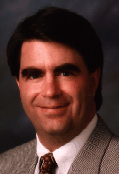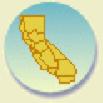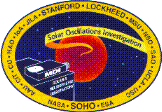Todd
Hoeksema
Who am I?
 I'm a solar physicist who studies how the Sun changes in time and how
those changes influence our Earthly environment. My wife, Carole,
is a CV nurse in the operating room at Sequoia Hospital. My three kids
are now in college, high school, and junior high. We have
two cats and two dogs. My hobbies include reading, games, and going
to plays. I'm a science fiction fan: books, movies, and TV.
I love good food - eating it better than making it. I'm a member
of the Palo Alto Christian Reformed Church (my dad was a minister).
I'm a solar physicist who studies how the Sun changes in time and how
those changes influence our Earthly environment. My wife, Carole,
is a CV nurse in the operating room at Sequoia Hospital. My three kids
are now in college, high school, and junior high. We have
two cats and two dogs. My hobbies include reading, games, and going
to plays. I'm a science fiction fan: books, movies, and TV.
I love good food - eating it better than making it. I'm a member
of the Palo Alto Christian Reformed Church (my dad was a minister).
Where am I?
I've been at Stanford University since 1978, ever since I came
to graduate school. Redwood City, where I live, is in the San Francisco Bay Area
in northern California and must be one of the best places to live in the
world. Our Solar Observatories group is part of the Hansen Experimental
Physics Laboratory - HEPL is associated with the Physics and Applied Physics
Departments here at the University. We often work with
scientists and engineers at Lockheed-Martin through the Stanford Lockheed
Institute for Space Research. The MDI instrument on SOHO was
built by our groups. Now we're working on the Helioseismic and Magnetic Imager (HMI)
for the Solar Dynamics Observatory mission that will launch in 2008.
The SOHO spacecraft orbits the Sun and always stays about a million
 miles sunward of the Earth. With it we constantly watch what the
Sun is doing. The Wilcox Solar Observatory is a lot closer - just
up in the hills behind the University campus.
My office used to be upstairs and had a window looking south, so I could keep an
eye on the Sun throughout the day. We recently moved into another building.
miles sunward of the Earth. With it we constantly watch what the
Sun is doing. The Wilcox Solar Observatory is a lot closer - just
up in the hills behind the University campus.
My office used to be upstairs and had a window looking south, so I could keep an
eye on the Sun throughout the day. We recently moved into another building.
How did I get here?
I loved the stars when I as a child and remember getting
up in the wee hours of the morning to watch the first astronauts go into
space. I also remember spending some pretty cold evenings outside
watching for meteors and trying to figure out how to use my very own little
telescope to see things as amazing as the pictures Mr. Wizard showed on
TV. It was pretty exciting for a little kid in Mt. Vernon, Washington.
I liked school, especially math and science; reading was fun, but
writing was always a chore for me. I graduated from the Prairie
School in Racine, Wisconsin and from there went to Calvin College in Grand
Rapids, Michigan. Then it was on to Stanford University in California.
By that point I had pretty much given up on astronomy as a career.
The job market was very tight. But a summer job working with Phil Scherrer
and John Wilcox at Stanford was enough to convince me that I had a
future in studying the Sun. Since I completed my Ph.D. in 1984 I've
continued to work at Stanford because it's always seemed like the most
exciting place to be in Solar Physics. I spent a few exciting
years at NASA Headquarters from 2000-2004,
but am enjoying the return to research.
What do I do?
 I'm curious about how and why the Sun varies and want to figure out
how changes of our star might affect us here on Earth or out in space.
That involves studying the Sun and measuring it's magnetic field.
The magnetic field causes all of the changes we really care about, but
no one really understands the details of how it works. We just see
the surface of the Sun, but most of the real action is happening down below.
We can use echoing sound waves to probe the depths of the Sun.
I'm curious about how and why the Sun varies and want to figure out
how changes of our star might affect us here on Earth or out in space.
That involves studying the Sun and measuring it's magnetic field.
The magnetic field causes all of the changes we really care about, but
no one really understands the details of how it works. We just see
the surface of the Sun, but most of the real action is happening down below.
We can use echoing sound waves to probe the depths of the Sun.
I'd like to find out how large changes are ultimately caused by smaller
ones. For example, no one understands what causes big explosions of
material in the Sun's atmosphere, called Coronal Mass Ejections.
These CMEs cause important disruptions in the Earth's magnetic field.
Those disturbances can cause problems with communications,
power grids, prospecting, and navigation.
Sunspots occur pretty frequently, but the size and number of spots changes
with an 11-year pattern. Funny twisting patterns in
the churning outer layers of the Sun intensify the magnetic fields that cause
the sunspots, but what makes them appear when and how they do?
Thousands of much smaller magnetic regions on the solar surface are
constantly appearing and disappearing. They gradually change the larger
magnetic patterns created by the sunspots.
I think these small changes eventually build up and cause the catastrophic explosions
in the Sun's atmosphere.
The little changes seem random, but can we find some order there?
By comparing
different events and looking at lots of measurements I hope to figure
some of it out.
What is a typical day like?
 Every day is different.
There's always a new problem to solve, a different event to investigate,
the latest data to evaluate, a change in plans to make, a paper to write
or revise, another question from a student or colleague, a meeting to
organize, a computer program
to debug, a movie to make, a budget to change, a proposal to write for
next year's research, a trip to a meeting to present new results and hear
new ideas, a visit to a local school, a filming session for an educational
video, a chance to offer advice to a journal editor about the merits of
a new paper, a session to develop long-term goals for solar physics,
a broken circuit board to repair, a journal article to read, a web page
to design, a request to provide some data, a progress report to write, a recommendation
to compose ...
Every day is different.
There's always a new problem to solve, a different event to investigate,
the latest data to evaluate, a change in plans to make, a paper to write
or revise, another question from a student or colleague, a meeting to
organize, a computer program
to debug, a movie to make, a budget to change, a proposal to write for
next year's research, a trip to a meeting to present new results and hear
new ideas, a visit to a local school, a filming session for an educational
video, a chance to offer advice to a journal editor about the merits of
a new paper, a session to develop long-term goals for solar physics,
a broken circuit board to repair, a journal article to read, a web page
to design, a request to provide some data, a progress report to write, a recommendation
to compose ...
Quite a variety. That's part of the fun.
Why do I do it?
 Astronomy is fascinating.
The Sun is the only star we can study up close, so it tells us a lot about
the universe that we cannot learn in any other way.
Astronomy is fascinating.
The Sun is the only star we can study up close, so it tells us a lot about
the universe that we cannot learn in any other way.
Solar astronomy is also practical. The Sun affects us every day,
yet we don't understand just how or why. Our society is becoming increasingly
sensitive to disturbances caused by the Sun. From the disruption
of pagers to errors in GPS navigation, from changes in climate to the
threats to satellites and life in space,
we realize more and more often how dependent we are on the Sun's good behavior.
Working with people whose first thought is 'How does it work?' instead
of 'How soon can we leave?' helps make each day exciting. The
technology of space flight is amazing. Travel to interesting
destinations for meetings was an unexpected bonus of solar physics,
though after a while even that can be a little tiresome.
The sense of continuous progress toward understanding something
very complex is very satisfying, something like solving a challenging puzzle.
Scientific investigation of the world around us strengthens my belief that
our world is well ordered and inherently understandable. We need
to treasure it.
 I'm a solar physicist who studies how the Sun changes in time and how
those changes influence our Earthly environment. My wife, Carole,
is a CV nurse in the operating room at Sequoia Hospital. My three kids
are now in college, high school, and junior high. We have
two cats and two dogs. My hobbies include reading, games, and going
to plays. I'm a science fiction fan: books, movies, and TV.
I love good food - eating it better than making it. I'm a member
of the Palo Alto Christian Reformed Church (my dad was a minister).
I'm a solar physicist who studies how the Sun changes in time and how
those changes influence our Earthly environment. My wife, Carole,
is a CV nurse in the operating room at Sequoia Hospital. My three kids
are now in college, high school, and junior high. We have
two cats and two dogs. My hobbies include reading, games, and going
to plays. I'm a science fiction fan: books, movies, and TV.
I love good food - eating it better than making it. I'm a member
of the Palo Alto Christian Reformed Church (my dad was a minister).
 miles sunward of the Earth. With it we constantly watch what the
Sun is doing. The Wilcox Solar Observatory is a lot closer - just
up in the hills behind the University campus.
My office used to be upstairs and had a window looking south, so I could keep an
eye on the Sun throughout the day. We recently moved into another building.
miles sunward of the Earth. With it we constantly watch what the
Sun is doing. The Wilcox Solar Observatory is a lot closer - just
up in the hills behind the University campus.
My office used to be upstairs and had a window looking south, so I could keep an
eye on the Sun throughout the day. We recently moved into another building.
 I'm curious about how and why the Sun varies and want to figure out
how changes of our star might affect us here on Earth or out in space.
That involves studying the Sun and measuring it's magnetic field.
The magnetic field causes all of the changes we really care about, but
no one really understands the details of how it works. We just see
the surface of the Sun, but most of the real action is happening down below.
We can use echoing sound waves to probe the depths of the Sun.
I'm curious about how and why the Sun varies and want to figure out
how changes of our star might affect us here on Earth or out in space.
That involves studying the Sun and measuring it's magnetic field.
The magnetic field causes all of the changes we really care about, but
no one really understands the details of how it works. We just see
the surface of the Sun, but most of the real action is happening down below.
We can use echoing sound waves to probe the depths of the Sun.
 Every day is different.
There's always a new problem to solve, a different event to investigate,
the latest data to evaluate, a change in plans to make, a paper to write
or revise, another question from a student or colleague, a meeting to
organize, a computer program
to debug, a movie to make, a budget to change, a proposal to write for
next year's research, a trip to a meeting to present new results and hear
new ideas, a visit to a local school, a filming session for an educational
video, a chance to offer advice to a journal editor about the merits of
a new paper, a session to develop long-term goals for solar physics,
a broken circuit board to repair, a journal article to read, a web page
to design, a request to provide some data, a progress report to write, a recommendation
to compose ...
Every day is different.
There's always a new problem to solve, a different event to investigate,
the latest data to evaluate, a change in plans to make, a paper to write
or revise, another question from a student or colleague, a meeting to
organize, a computer program
to debug, a movie to make, a budget to change, a proposal to write for
next year's research, a trip to a meeting to present new results and hear
new ideas, a visit to a local school, a filming session for an educational
video, a chance to offer advice to a journal editor about the merits of
a new paper, a session to develop long-term goals for solar physics,
a broken circuit board to repair, a journal article to read, a web page
to design, a request to provide some data, a progress report to write, a recommendation
to compose ...
 Astronomy is fascinating.
The Sun is the only star we can study up close, so it tells us a lot about
the universe that we cannot learn in any other way.
Astronomy is fascinating.
The Sun is the only star we can study up close, so it tells us a lot about
the universe that we cannot learn in any other way.